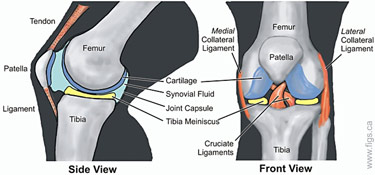The knee – formed where the bottom of the thigh bone (femur) meets the top of the shin bone (tibia) – is arguably the body’s largest and most complex weight-bearing joint. When the knee is healthy, the joint moves freely. This is because the joint is covered with white elastic materials called cartilage and powered by large muscles.
Cartilage is a layer of smooth, soft tissue. It covers the contact points of the three bones making up the knee joint: patella (kneecap), femur and tibia. Healthy cartilage absorbs stress and allows the knee to glide easily.
The meniscus, shaped like a half-moon, cups the condyle, the prominent rounded ridges at the end of the femur. The meniscus acts as a shock absorber distributing the compressive forces.
Collateral and cruciate ligaments are another type of soft tissue. They hold the bones of the joint together and provide front-to-back and side-to-side stability to the joint.
Muscles power the knee and leg for movement.
Tendons attach the muscles to the bones.

Surgery stops the pain and sets you free
Visit our Patient Information Resources page for more information and resources.

